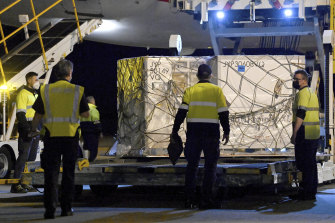Dark days lie ahead despite Andrews slow COVID reopening
The road map released by the Victorian government on Sunday finally charts a course out of COVID’s seemingly endless lockdowns to a more normal life, but the modelling commissioned by government suggests that path takes us through some of the pandemic’s darkest days and weeks.
As slow and careful as the road map is, it will allow the virus to spread, the Burnet Institute’s best guess says, and the toll we have avoided for so long of new cases, hospitalisations and deaths will come along with it.

Airport workers unload pallets of the first shipment of the Moderna COVID-19 vaccination as it arrives in Sydney on Friday.Credit:AAP Pool
It predicts a peak in average infections of between 1400 and 2900 per day in the last two weeks of October â€" and then a second, much larger peak of around 4000 cases per day at the end of December. It predicts a better than one-in-two chance of the healthcare system being overwhelmed.
Without vaccines the path would be considerably worse. Indeed, the overwhelming majority of serious illness and death will be among the unvaccinated, and for those people, particularly in older age groups, the outlook is grim.
Up until now, they have been protected from COVID-19 by the efforts of the community to limit the virus circulating. This, according to the modelling, will change rapidly in coming weeks.
Should you remain unvaccinated, you face a dramatically higher risk of catching COVID-19. At the same time you will be treated in a stretched healthcare system. Modellers expect mortality rates to jump when healthcare systems get overwhelmed.
How accurate are the Burnet Institute’s projections? Will we really have 120,000 new infections in December? It is hard to know at this stage. Given Victoria recorded just 507 cases on Sunday, future projections about the course of the pandemic are extremely uncertain.
Models are, ultimately, sophisticated guesses â€" the modern version of soothsayers reading the future in chicken entrails. Expect a week of scientific debate over this one’s underlying assumptions.
The second takeaway is about the direction Victoria has chosen.
Premier Daniel Andrews and Chief Health Officer Brett Sutton have come under regular criticism that their approach to COVID-19 has been too cautious.
There was an opportunity for more caution at this juncture.
Mr Andrews could have used the Burnet Institute’s modelling to support a decision to avoid reopening at 80 per cent vaccination rates, and demand we push up toward 90 per cent â€" as other COVID-free states have done. Doing so would substantially cut the likely number of deaths.
He chose not to do this. We can read a lot into the reporting that suggests cabinet ministers pushed to reopen schools in October over the objections of Professor Sutton, who preferred to wait till November. It is now clear who won that argument.
The road map represents a substantially more risky option than staying in lockdown or opening only partially, at least in terms of infections and deaths.
But such is the reality of COVID-19. Choosing to open and live with the virus, rather than seek elimination â€" as some senior scientific voices have called for â€" means cases and deaths. Such is the trade-off for a return to something approximating life as normal.
“Remaining closed forever has its own cost,†Mr Andrews said on Sunday. “We are opening up, no doubt about that. There will be no turning back. We have to normalise this, we have to pass through this pandemic.â€
Liam Mannix’s Examine newsletter explains and analyses science with a rigorous focus on the evidence. Sign up to get it each week.

0 Response to "Dark days lie ahead despite Andrews slow COVID reopening"
Post a Comment